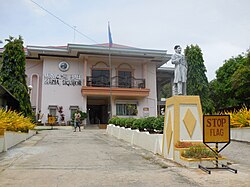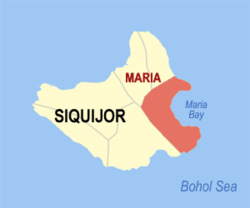Municipality in Siquijor, Philippines
Municipality in Negros Island Region, Philippines
Maria , officially the Municipality of Maria (Cebuano : Lungsod sa Maria ; Tagalog : Bayan ng Maria ), is a municipality in the province of Siquijor , Philippines. According to the 2020 census, it has a population of 14,385.[ 4]
Maria is 32 kilometres (20 mi) from Siquijor .
Geography
The man-made Salagdoong Forest
Barangays
Maria is politically subdivided into 22 barangays. Each barangay consists of puroks and some have sitios .
PSGC
Barangay
Population
±% p.a.
2020 [ 4]
2010 [ 6]
076104001 Bogo
5.9%
851
739
▴
1.42%
076104002 Bonga
3.9%
555
459
▴
1.92%
076104003 Cabal‑asan
2.7%
389
357
▴
0.86%
076104004 Calunasan
4.5%
643
641
▴
0.03%
076104005 Candaping A
4.0%
582
448
▴
2.65%
076104006 Candaping B
4.8%
684
591
▴
1.47%
076104007 Cantaroc A
3.2%
462
385
▴
1.84%
076104008 Cantaroc B
3.5%
501
411
▴
2.00%
076104009 Cantugbas
2.9%
412
400
▴
0.30%
076104010 Lico‑an
3.4%
496
529
▾
−0.64%
076104011 Lilo‑an
10.1%
1,459
1,470
▾
−0.08%
076104013 Logucan
4.5%
647
557
▴
1.51%
076104012 Looc
3.4%
489
528
▾
−0.76%
076104014 Minalulan
5.9%
843
703
▴
1.83%
076104015 Nabutay
7.0%
1,000
718
▴
3.37%
076104016 Olang
4.9%
701
592
▴
1.70%
076104017 Pisong A
2.5%
366
292
▴
2.28%
076104018 Pisong B
1.7%
249
293
▾
−1.61%
076104019 Poblacion Norte
8.0%
1,153
1,170
▾
−0.15%
076104020 Poblacion Sur
4.6%
656
675
▾
−0.29%
076104021 Saguing
5.6%
803
946
▾
−1.63%
076104022 Sawang
3.1%
444
479
▾
−0.76%
Total
14,385
13,383
▴
0.72%
Climate
Climate data for Maria, Siquijor
Month
Jan
Feb
Mar
Apr
May
Jun
Jul
Aug
Sep
Oct
Nov
Dec
Year
Mean daily maximum °C (°F)
29
30
31
32
31
30
30
30
30
29
29
29
30
Mean daily minimum °C (°F)
22
22
22
23
24
24
24
24
24
24
23
23
23
Average precipitation mm (inches)
26
22
28
41
95
136
147
126
132
150
98
46
1,047
Average rainy days
7.5
6.7
8.9
10.4
21.6
25.6
26.3
25.0
24.1
26.2
19.2
12.1
213.6
Source: Meteoblue[ 7]
Demographics
Population census of Maria Year ±% p.a. 1903 6,499 — 1918 8,477 +1.79% 1939 8,722 +0.14% 1948 8,547 −0.22% 1960 9,335 +0.74% 1970 9,942 +0.63% 1975 10,778 +1.63% 1980 10,951 +0.32% 1990 11,140 +0.17% 1995 11,106 −0.06% 2000 12,275 +2.17% 2007 12,974 +0.77% 2010 13,383 +1.14% 2015 13,828 +0.62% 2020 14,385 +0.78% Source: Philippine Statistics Authority [ 8] [ 6] [ 9] [ 10]
Economy
Salagdoong Beach Poverty incidence of Maria
Education
The public schools in the town of Maria are administered by one school district under the Schools Division of Siquijor .
Elementary schools:
Bogo Elementary School — Bogo
Candaping Elementary School — Candaping B
Cantaroc Elementary School — Cantaroc B
Cantugbas Elementary School — Cantugbas
Lico-an Elementary School — Lico-an
Lilo-an Elementary School — Lilo-an
Logucan Elementary School — Logucan
Minalulan Elementary School — Minalulan
Nabutay Elementary School — Nabutay
Pisong A Elementary School — Pisong A
Pisong B Elementary School — Pisong B High schools:
Candaping National High School — Candaping B Integrated schools:
Maria Integrated School (formerly Maria CS ) — Poblacion Norte
References
^ Municipality of Maria | (DILG) ^ "2015 Census of Population, Report No. 3 – Population, Land Area, and Population Density" (PDF) . Philippine Statistics Authority . Quezon City, Philippines. August 2016. ISSN 0117-1453 . Archived (PDF) from the original on May 25, 2021. Retrieved July 16, 2021 .^ https://www.philatlas.com/visayas/r07/siquijor/maria.html . ^ a b c Census of Population (2020). "Region VII (Central Visayas)" . Total Population by Province, City, Municipality and Barangay . Philippine Statistics Authority . Retrieved 8 July 2021 . ^ "PSA Releases the 2021 City and Municipal Level Poverty Estimates" . Philippine Statistics Authority. 2 April 2024. Retrieved 28 April 2024 .^ a b Census of Population and Housing (2010). "Region VII (Central Visayas)" (PDF) . Total Population by Province, City, Municipality and Barangay . National Statistics Office . Retrieved 29 June 2016 . ^
"Maria: Average Temperatures and Rainfall" . Meteoblue. Retrieved 28 April 2020 .
^ Census of Population (2015). "Region VII (Central Visayas)" . Total Population by Province, City, Municipality and Barangay . Philippine Statistics Authority . Retrieved 20 June 2016 . ^ Censuses of Population (1903–2007). "Region VII (Central Visayas)" . Table 1. Population Enumerated in Various Censuses by Province/Highly Urbanized City: 1903 to 2007 National Statistics Office . ^
"Province of Siquijor" . Municipality Population Data . Local Water Utilities Administration Research Division. Retrieved 17 December 2016 .
^ "Poverty incidence (PI):" . Philippine Statistics Authority. Retrieved December 28, 2020 .^ "Estimation of Local Poverty in the Philippines" (PDF) . Philippine Statistics Authority. 29 November 2005.^ "2003 City and Municipal Level Poverty Estimates" (PDF) . Philippine Statistics Authority. 23 March 2009.^ "City and Municipal Level Poverty Estimates; 2006 and 2009" (PDF) . Philippine Statistics Authority. 3 August 2012.^ "2012 Municipal and City Level Poverty Estimates" (PDF) . Philippine Statistics Authority. 31 May 2016.^ "Municipal and City Level Small Area Poverty Estimates; 2009, 2012 and 2015" . Philippine Statistics Authority. 10 July 2019.^ "PSA Releases the 2018 Municipal and City Level Poverty Estimates" . Philippine Statistics Authority. 15 December 2021. Retrieved 22 January 2022 .^ "PSA Releases the 2021 City and Municipal Level Poverty Estimates" . Philippine Statistics Authority. 2 April 2024. Retrieved 28 April 2024 .
External links
Wikimedia Commons has media related to
Maria .
Places adjacent to Maria, Siquijor






